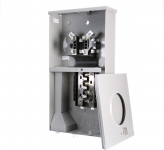I have the same question and notice it was not answered in this thread. We install service entrance rated transfer switches which are factory bonded and contain an OCPD. In our area most of the (existing) homes have a meter outside and main breaker panel (or 2) located inside, sometimes upstairs in a central laundry room and the SEU cable feeding it is nearly impossible to replace. From what I read they can both remain bonded and nothing has to be changed as long as we put a sticker on the outdoor ats calling it an emergency disconnect, not service disconnect. Is this correct? Or more importantly, safe?

